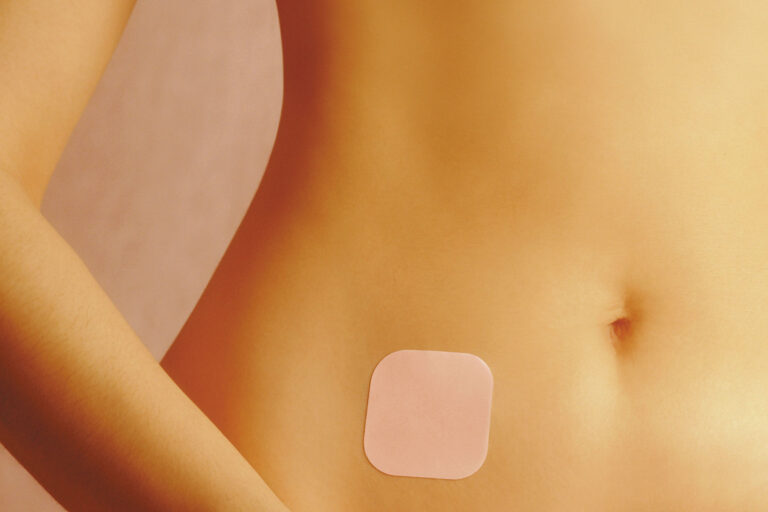Making the choice to use birth control is a personal and important decision. With so many birth control options available, it can be overwhelming and confusing to determine which of these birth control methods is right for you.
In recent years, the birth control patch has gained popularity as an alternative to the contraceptive pill. Both methods have their own unique benefits and considerations, and it’s important to understand them before making a decision.
In this article, Dr. Michelle Chia, Medical Director of Ezra Clinic, shares insights from her personal experience and explores the differences between the birth control patch and pill. She provides insight into how they work, their effectiveness rates, potential side effects, and other factors that may influence your choice of them over other birth control methods.
You can make an informed decision about which of the two birth control methods best fits your lifestyle and needs by understanding these key points. This will help you to select the most suitable birth control method for yourself, be it the combination of birth control pills or the patch.
Birth Control Patch
The contraceptive patch is a small, sticky skin patch. The patch can be worn on the buttock, abdomen, upper back, or upper outer arm, and a different site can be selected each week.
The birth control patch is administered by applying a small, sticky patch to the skin, which releases hormones into the bloodstream to get you protected against pregnancy. This type of birth control method contains the hormones estrogen and progestin. The birth control patch works by preventing ovulation, thickening cervical mucus, and thinning the womb lining for the fertilized egg to be less likely to implant itself. It is effective (97-98%) at preventing pregnancy.
The birth control patch should be applied once a week for three weeks in a row. A new patch is applied each week on the same day of the week for three weeks, and then a patch-free week follows. During the patch-free week, the old patch is removed for 1 week, and menstrual bleeding occurs. After the fourth week, a new patch is applied, and the cycle is repeated.
The birth control patch users consider them as convenient. It only needs to be applied once a week compared to the daily birth control pills, making it easier for people who may forget to take a daily pill. The contraceptive patch also helps regulate the menstrual cycle, make periods lighter and less painful, and reduce premenstrual symptoms.
Pros
Convenience: It only needs to be applied once a week, making it easier for people who may forget to take their daily birth control pills. Convenience is one of the key factors that makes the contraceptive patch a preferred method compared to combination birth control pills.
Regulated Menstrual Cycle: Both birth control methods can make periods more regular, lighter, and less painful and can help reduce premenstrual symptoms.
Other Health Benefits: It can help with acne and bone thinning and prevent certain conditions such as cysts in the breasts and ovaries, ectopic pregnancy, and endometrial and ovarian cancers.
Effectiveness: When used correctly, it is more than 98% effective at preventing pregnancy
Cons
Visible on the Body: Some people may not like that the patch is visible on the skin.
Skin Irritation: It may cause skin irritation, itching, or soreness in some individuals.
Weekly Application: It must be changed weekly, and some users may find it challenging to remember to change a new patch on time.
Prescription Required: A prescription is needed to obtain the patch.
Does Not Protect Against STIs: It does not protect against sexually transmitted infections. Use condoms in addition to the patch is recommended for protection against sexually transmitted infections.
What are the Side Effects
The birth control patch, like other forms of hormonal birth control, can have various side effects. Some of these side effects are similar to those experienced with the birth control pill.
Common Side Effects:

Nausea
Headaches
Bloating
Breakthrough bleeding
Mood changes
Skin reactions at the application site (e.g., itching, dryness, pain, swelling, or a rash)
Spotting (light bleeding or brown discharge)
Sore breasts
Less Common Side Effects:
Changes in sexual desire
weight gain
Slightly higher risk of blood clot
It’s important to note that most of these side effects disappear after 2 or 3 months. However, if any side effects are persistent or concerning, it’s recommended that a health care provider be consulted.
Who is Eligible to Use Birth Control Patch?
The birth control patch is a convenient and safe contraceptive method for many individuals. However, it may not be suitable for everyone. Here’s a summary of who is eligible to use contraceptive patches and the conditions under which it should be avoided:
Eligible to Use the Contraceptive Patch:
Individuals who are sexually active and seeking a convenient form of birth control.
The effectiveness of the patch may be reduced in individuals above a certain weight
People who find it challenging to remember to take a daily pill or have trouble swallowing pills.
Conditions to Avoid:
The birth control patch may not be appropriate for individuals who are age 35 or older and smoke.
Those with a history of blood clots, chest pain, heart attack, stroke, severe high blood pressure, breast, uterine, or liver cancer.
Individuals with liver disease, migraines with aura, unexplained vaginal bleeding, or a history of certain medical conditions
People with a history of skin reactions at the application site
Birth Control Pill

Birth control pills, also known as “the Pill,” are a form of oral contraceptive that uses hormones to prevent pregnancy. Birth control pills work by affecting the uterine lining to prevent fertilized egg implantation, thickening the cervical mucus to block sperm, and preventing ovulation.
The birth control pill is typically administered orally, as it is a daily pill that contains hormones to prevent pregnancy. Most combination pills are in either a 21-day pack or a 28-day pack. One hormone pill is taken daily at about the same time for 21 days. Depending on the specific pack, there may or may not be placebo pills.
When taken consistently every day, the pill is up to 99% effective at preventing pregnancy. Oral contraceptives are also considered convenient to use by many people. The pill is small and easy to carry, and there are also birth control apps available to help remind users to take their pills every day.
Birth control pills reduce acne, make periods lighter and more regular, ease menstrual cramps, and lower the risk of ovarian and uterine cancers. They come in two main types: combination pills (containing both progestin and estrogen) and progestin-only pills.
People may prefer one type over the other based on various factors such as their medical history, potential side effects, and individual preferences. For example, the progestin-only pill may be a better option for those who are sensitive to estrogen, while the combination pill may be preferred for its non-contraceptive benefits, such as more regular periods and reduced menstrual cramps.
Pros
The birth control pill is 99% effective.
It can make periods lighter, shorter, and more regular and reduce menstrual cramps.
It reduces the risk of ovarian and uterine cancer.
It can reduce the risk of ectopic pregnancy, cysts in the breasts and ovaries
It can help manage PMS symptoms.
It is a safe, simple, and convenient way to prevent pregnancy.
Cons
The pill may cause side effects such as breast tenderness, mood changes, reduced libido, and nausea.
It may cause irregular spotting or bleeding, especially during the first few months of use.
It may not work as well if certain medications or supplements are taken.
It does not protect against STIs.
It may increase the risk of blood clot formation
It is not suitable for everyone, such as those over 35 who smoke or have certain medical conditions.
What are the Side Effects

The birth control pill may cause several side effects, including:
Nausea
Headaches
Spotting or bleeding between periods
Sore breasts
Bloating
Increased blood pressure
Changes in menstrual periods
Mood changes
Decreased sex drive
Weight changes
These side effects are usually temporary and may improve after a few months of using the pill. However, if the side effects persist or are severe, it’s important to consult a health care provider. In rare cases, the pill may also pose serious risks like blood clots, heart attack, stroke, and liver disorders, especially in individuals who smoke or have certain medical conditions.
Who is Eligible to Use Birth Control Pills?
The eligibility to use birth control pills is determined based on an individual’s medical history and current health status. The U.S. Medical Eligibility Criteria for Contraceptive Use (US MEC) provides guidance on the use of specific contraceptive methods. According to these recommendations, the eligibility for using birth control pills is categorized as follows:
1: Method can be used without restriction
2: Method generally can be used, but follow-up may be required
3: Method not recommended unless there are no other appropriate methods available
4: Unacceptable health risks using the method
Individuals who are generally eligible to use birth control pills without restriction (Category 1) include those who are not pregnant, do not have a history of breast cancer, and do not have a history of blood clots. However, it is important for health care providers to consider the individual clinical circumstances of each person when counselling them about contraceptive choices. It would be advisable to consult with a doctor experienced in women’s health for this.
On the other hand, there are certain medical conditions that may pose an unacceptable health risk if birth control pills are used (Category 4). These may include individuals with a history of blood clots, certain types of liver tumours, uncontrolled high blood pressure, and those who are over the age of 35 and smoke. For these individuals, alternative contraceptive methods may be more appropriate.
Risk Factors of Using These Contraceptives
The use of birth control patches and pills carries some risks. According to Mayo Clinic, the birth control patch may increase the risk of blood-clotting problems, high blood pressure, stroke, and liver issues. The patch may not be appropriate for everyone, especially those who are 35 years old or older and smoke, have a history of heart attack or chest pain, stroke, or high blood pressure, have a history of blood clots, breast, uterine, or liver cancer, weigh more than 198 pounds, have liver disease or migraines, or have unexplained vaginal bleeding.
The birth control pill, patch, and ring may increase the risk of deep vein thrombosis (DVT). The most common side effects of the birth control patch and pill are bleeding or spotting between periods, nausea, sore breasts, or headaches, but these usually go away after 2 or 3 months. The patch may cause skin irritation, and the pill may cause mood changes, weight gain, and a loss of sexual desire.
Conclusion
Both the patch and pill are two popular hormonal contraceptive options, each with unique benefits.
The patch is a sticky patch applied to the skin weekly and can regulate menstrual cycles, make periods lighter, and reduce premenstrual symptoms. However, it can be visible on the skin, cause irritation, and must be changed weekly.
The birth control pill requires daily intake. Both may have side effects like irregular bleeding, nausea, and breast tenderness, which generally subside after a few months. Eligibility for the patch includes sexually active individuals who desire convenience and those under a specific weight threshold. It’s unsuitable for people at risk of blood clots or certain cancers.
In making a decision, consider factors such as lifestyle, convenience, and personal health history. Consult a health care provider when choosing the most appropriate contraceptive method.








